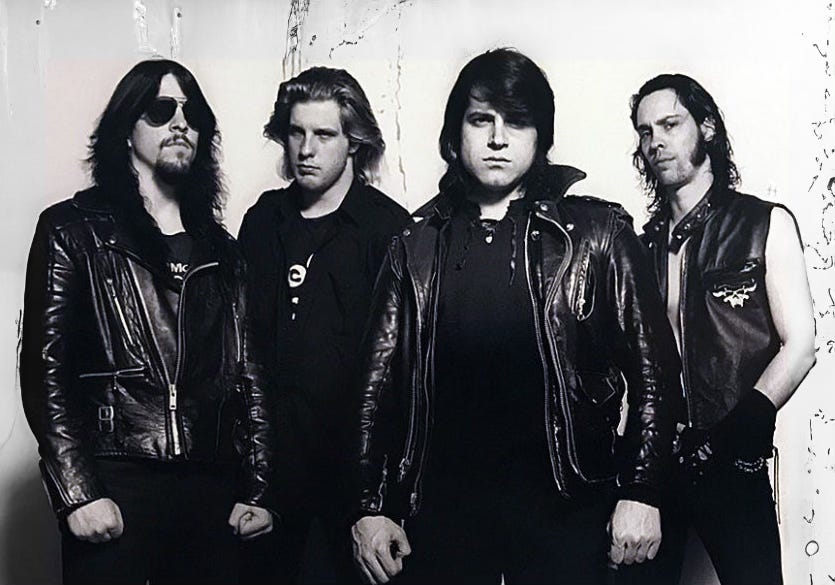Danzig | History of the Band
From Punk Roots to Gothic Metal Icons - Exploring the Dark Evolution of a Cult Legend in the 80s
Danzig reigns as a seminal force when it comes to bands that sculpted the landscape of '80s metal with a distinctive blend of bluesy doom and hard-edged rock. Born from the embers of punk and classic metal, Danzig's journey through the 1980s and early 1990s carved out a niche that resonates strongly with Gen X music aficionados even today. For those who remember leather jackets, the ominous allure of vinyl, and the first wave of music video culture, Danzig's story is not just about music but a potent echo of a vibrant era.
Jason Bodak suggested this artist for a future Dig Me Out podcast episode. Each month, our Patrons are presented with a selection of albums suggested by listeners and asked to vote for their favorite.
Formation and Early Years
Danzig emerged in 1987, founded by vocalist Glenn Danzig, formerly of the horror punk bands Misfits and Samhain. This transition marked a stylistic shift from punk to a more heavy, brooding metal sound. The original lineup included Eerie Von on bass, John Christ on guitar, and Chuck Biscuits on drums, each bringing their distinct influence to the band's early sound. The band was named after Glenn Danzig's stage name, an iconic emblem within the punk and metal communities.
Musical Style and Evolution
Initially, Danzig's music fused gothic atmospheres with blues-infused rock and metal, setting them apart from the thrash-dominated scene of the time. This unique blend was reflected in Glenn's baritone, which conjured up comparisons with legends like Jim Morrison and Elvis Presley. Over the late '80s, Danzig's style evolved to incorporate a darker, more ominous tone, which became a hallmark of their music, influencing many bands in the gothic rock and heavy metal genres.
Discography and Notable 80s Albums
"Danzig" (1988): Released under Def American Recordings and produced by Rick Rubin, the band’s debut album "Danzig" marked a definitive shift in metal. With tracks like "Mother" and "Twist of Cain," the album introduced a dark, blues-infused sound that captivated listeners. "Mother" became particularly iconic, eventually climbing the charts during its re-release in the early '90s. The album was celebrated for blending haunting lyrical themes with compelling hard rock energy, setting the stage for Danzig's cult status.
"Danzig II: Lucifuge" (1990): Continuing the momentum, "Danzig II: Lucifuge" expanded on the themes and sound of their debut. Also produced by Rick Rubin and released by Def American, this album delved deeper into the gothic and blues elements for which the band was known. Tracks such as "Her Black Wings" and "Devil's Plaything" exemplified the band’s evolving sound and Glenn’s powerful lyrical storytelling. The album was critically acclaimed for its intricate blend of genres and is often noted for its refined darkness and lyrical depth.
Influence and Legacy
Critical reception of Danzig's work during the 1980s was largely positive, with many applauding their ability to blend musical intensity with lyrical depth. Music critics noted the band's skill in crafting haunting and invigorating atmospheres. "Danzig’s voice could raise demons from the deep, and often did," remarked one critic from Rolling Stone. This period also marked a significant moment where the band made their indelible mark not just in metal but in the broader spectrum of rock music.
The impact of Danzig can be seen in the swathes of bands that followed, from metal to alternative rock. Their dark aesthetic and thematic content paved the way for bands like Type O Negative and even later acts like Ghost. Moreover, Glenn Danzig’s influence extended beyond music; his dark, brooding persona helped shape the archetype of the rock frontman in subsequent decades. Several band members explored other projects after their tenure with Danzig, further spreading their musical influence across various genres.
Danzig's contribution to the '80s metal scene might not have dominated headlines like some of their contemporaries. Still, their musical journey is a crucial puzzle in understanding the era. Their unique blend of gothic imagery and blues-infused metal created a distinct niche that not only defined their career but also influenced the trajectory of rock music into the early '90s. For many, revisiting Danzig's albums is a rediscovery of a band that shaped the darker contours of rock music, creating a legacy that endures in the chords and choruses that resonate with fans across generations.



